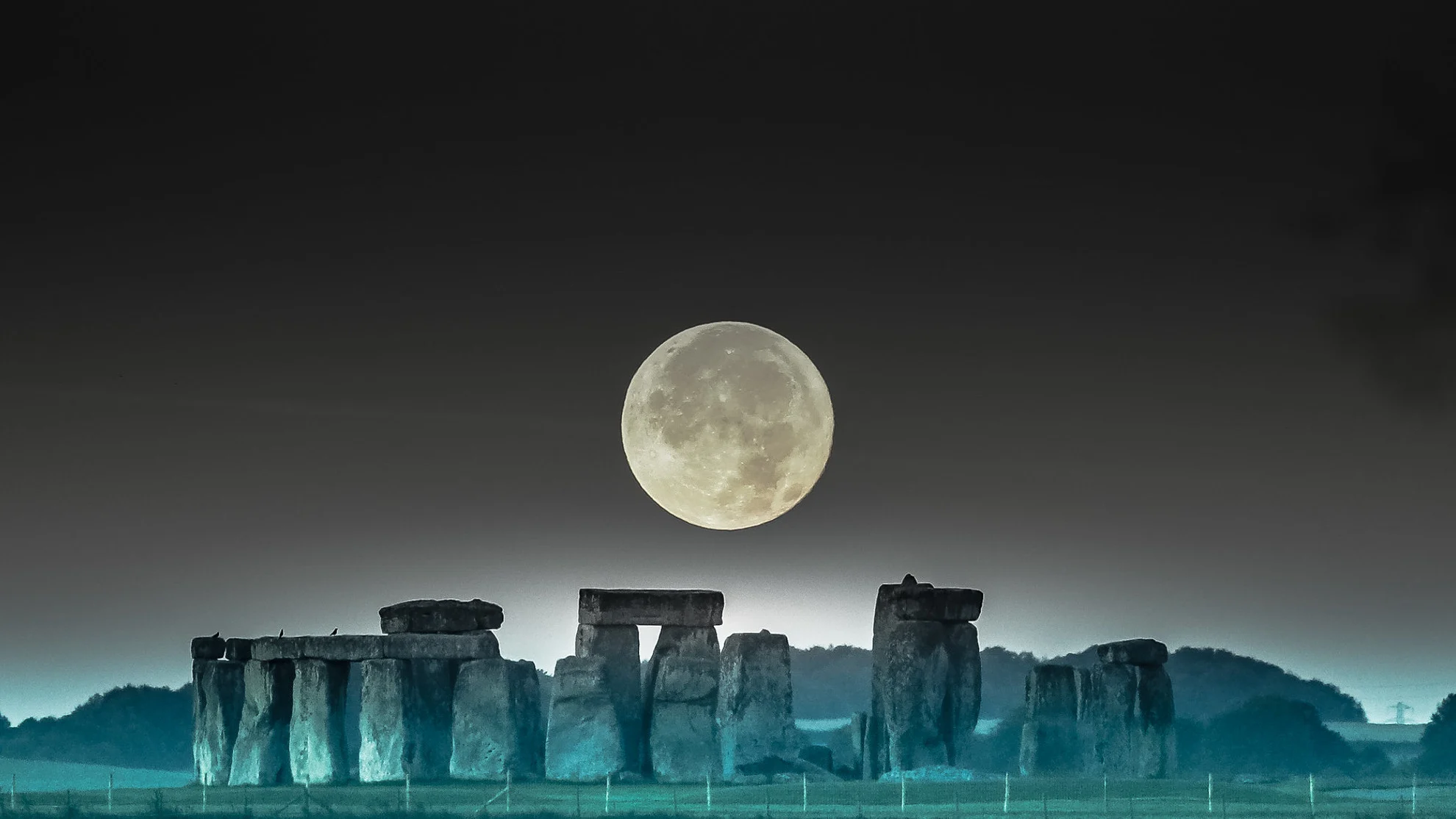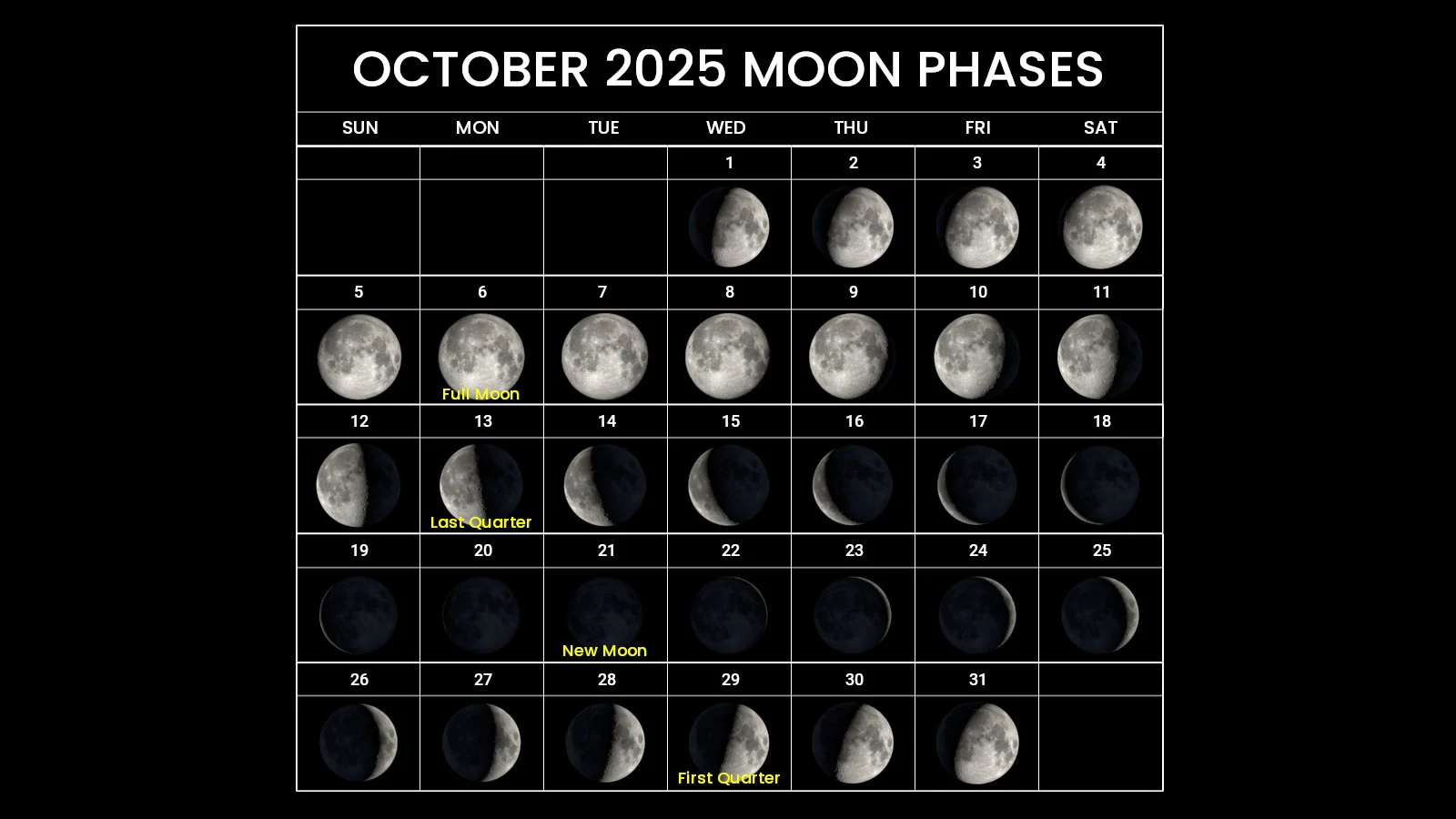
Meteor showers and the Harvest Moon light up our October night skies
Look up for a possible meteor storm, a 'super' Harvest Moon, and telescopes should be aimed to the east at the end of October to potentially spot an alien comet in our sky.
Eyes to the sky this month to see the Super Hunter's Harvest Moon, a potential meteor storm from the Draconids, the best viewing for the Orionids in nearly two decades, and a visit from an interstellar comet.
Here is the Astronomical Guide for October 2025:

The astronomical events for October 2025, including the phases of the Moon, planet-moon conjunctions, meteor showers, and the appearance of interstellar comet 3I/ATLAS. (Scott Sutherland, moon graphics from NASA's Scientific Visualization Studio, conjunctions courtesy Stellarium)
Visit our Complete Guide to Fall 2025 for an in depth look at the Fall Forecast, tips to plan for it and much more!
The Moon
The Waxing Gibbous Moon will rise each night at the start of the month, up until the Full Moon on the night of the 6th.
This will be 2025's Hunter's Moon (the traditional name of the October Full Moon). Additionally, as the closest Full Moon to the September Equinox, it is this year's Harvest Moon, and it is the first supermoon of the year as well. So, the Super Harvest Hunter's Moon?

(NASA SVS/Scott Sutherland)
The Waning Gibbous Moon will shine from the 7th through the 12th, with the Last Quarter Moon on the night of the 13th, and the Waning Crescent Moon visible in the eastern sky before sunrise from the 14th through the 20th.
The New Moon occurs on the 21st, making that the best night of the month for stargazing. This is especially well-timed for the peak of the Orionids (read on for more).
A Waxing Crescent Moon will be in the western sky just after sunset from the 22nd through the 28th, the First Quarter Moon is on the 29th, and we once again see the Waxing Gibbous Moon on the 30th and 31st.
READ MORE: Why are supermoons so compelling to us?
The Planets
Four of the brightest planets in our sky are visible each night throughout the month. To start, Mars can be seen in the west just after sunset, with Saturn in the east at the same time. Jupiter rises around 1 a.m., local time, with Venus rising in the hours just before sunrise.
Saturn, Jupiter, and Venus are still the bright points of the 'planet parade' that has stretched across our predawn skies for months. However, it is nearing its limit at the beginning of October.
If you have clear skies, scan overhead from the eastern horizon to the western horizon between 5 a.m. and 6:30 a.m., local time. Venus will be in the east, Jupiter to the southeast, and Saturn far to the west. Observers with a decent backyard telescope can find Uranus between Aldebaran and the Pleiades, while Neptune will be just to the east of Saturn.

The 'planet parade' ends by mid-October. (Stellarium/Scott Sutherland)
With Venus rising a bit later each morning, now, the other planets will be farther west every time it crests the eastern horizon. By the morning of the 11th, there will be only a brief period, starting around 5:30 a.m., local time, where all five planets might be seen in the sky, with Venus right above one horizon and Saturn right above the other. Observers will need a very clear view of both horizons for this, and higher elevation will also give a better view.
After that, the parade will be reduced down to four planets, and then it will drop down to just three a few days later as Neptune follows Saturn, slipping beyond the western horizon before Venus rises in the east.
Venus and Jupiter will still be easily spotted in the eastern sky before sunrise, all month long, though. The 14th and the 19th are excellent mornings to check them out, as the Waning Crescent Moon will be near Jupiter on the 14th, and then near Venus on the 19th.

The positions of Venus and Jupiter at 6:30 a.m. (local time) on October 1 and 31, 2025. (Stellarium/Scott Sutherland)
For planet-watchers who prefer evening observations, Mars will be near the western horizon each night, just after sunset. However, the Red Planet is getting closer and closer to the Sun right now, from our perspective. So, it will become more challenging to spot as it emerges from evening twilight.
Mercury joins Mars along the western horizon in the latter half of October. Both will be difficult to spot in twilight, though. On the night of October 23, use a telescope or pair of binoculars to look for the Waxing Crescent Moon right on the horizon. Its crescent will be ‘pointing’ towards the two planets, potentially making them easier to find.

The Waxing Crescent Moon 'points' towards Mercury and Mars on the evening of October 23, 2025. (Stellarium/Scott Sutherland)
The only planet visible for most of the night, right now, is Saturn. Having passed through Opposition — its closest distance to Earth — in late September, the planet is still reasonably bright. Find it in the eastern sky each evening, just after sunset, and watch it cross the sky for the rest of the night.
DON'T MISS: What is the mysterious Moon Illusion?
Meteor showers
During the month of October, a total of 4 different meteor showers send streaks of light across our night skies. However, only two of those reach their peak, the Draconids and the Orionids.

The radiant of the Draconid meteor shower in the northern constellation Draco, on October 8-9, 2025. (Stellarium/Scott Sutherland)
The Draconids stream out of the constellation Draco, in the northern sky, from October 6-10. This shower only delivers a handful of meteors each night, except during its peaks on the night of Oct. 8, when it typically produces around 5 meteors per hour.
Look back through history, though, and we can see that the Draconids have produced some spectacular outbursts of activity. In particular, in both 1933 and 1946, witnesses reported seeing thousands of Draconid meteors every hour during the shower's peak.
This year, we could see another of these outbursts, but not quite as strong as the ones from last century. The most conservative estimate increases the shower’s peak to around 50 per hour. However, it could be even stronger, with NASA's Meteoroid Environment Office saying that the Draconids could produce as many as 400 meteors per hour on that night!
Based on the NASA report, the meteoroids we encounter during this outburst could be fairly small. So, we may need to watch meteor radar to see the full effect, with lower rates (closer to the 50 per hour estimate) visible from here on the ground. Additionally, since the shower peaks just after October's Full Moon, the number of visible meteors will be further reduced by moonlight washing out the sky.

The best viewing for the Orionid meteor shower will be in the hours before sunrise on Oct 21, 2025. (Stellarium/Scott Sutherland)
The Orionid meteor shower overlaps with the Draconids, starting on October 2 and lasting until November 12. This is the second of two annual meteor showers produced by debris from Halley's Comet.
The shower is fairly weak for most of its run, delivering one or two meteors per hour each night. During its peak, though, in the predawn hours of October 21, we tend to see around 20 meteors per hour. This year, we benefit from the fact that the Orionids peak coincides with the New Moon, giving us ideal sky conditions for the show. In fact, this could be the best-timed Orionid meteor shower in decades!
Orionid meteors begin showing up around 10:00 p.m., local time, each night, including during the peak. The best time to watch, though, is in the hours before sunrise, when the shower's radiant is highest in the sky.
MORE FROM SPACE: A meteor storm and an alien comet could be the 'stars' in the sky this fall
The Alien Comet
For the past few months, astronomers have been tracking an alien visitor to our solar system. Comet 3I/ATLAS arrived here from interstellar space and is speeding by, giving us only a brief time to see it!

Comet 3I/ATLAS as imaged by the Gemini South observatory in Chile, on August 27, 2025. (International Gemini Observatory/NOIRLab/NSF/AURA/Shadow the Scientist, Image Processing: J. Miller & M. Rodriguez (International Gemini Observatory/NSF NOIRLab), T.A. Rector (University of Alaska Anchorage/NSF NOIRLab), M. Zamani (NSF NOIRLab))
So far, this comet has been too dim to spot using anything but our most powerful telescopes.
However, towards the end of October, it is expected to rise in the east just before predawn twilight, and be at its brightest as seen from here on Earth. It could be just bright enough (at around magnitude +14.9 to +15) to see using a large, 10-inch aperture backyard telescope, from October 30 through the first week of November.

The location of 3I/ATLAS in the eastern predawn sky in late October and early November, 2025. The planet Venus will be nearby on these mornings, providing an excellent marker to help locate the dim comet. (Stellarium/Scott Sutherland)
Use the planet Venus, from its position near the eastern horizon, as a convenient guide for locating the comet in the sky.
October Constellations
The constellations of fall dominate the sky this month.

(Stellarium/Scott Sutherland)
At the start of October, Pisces, Pegasus, Andromeda, Cetus, Taurus, Orion, Gemini, Cancer, and Leo are most prominent in the southern sky in the morning.
Bootes, Hercules, Cygnus, Aquilla, Sagittarius, Capricornus, and Pegasus dominate in the evening.

(Stellarium/Scott Sutherland)
Our view of the sky shifts slightly by the end of the month, however, Pisces, Pegasus, Andromeda, Cetus, Taurus, Orion, Gemini, Cancer, and Leo are still most prominent for the predawn hours. Hercules, Cygnus, Aquilla, Sagittarius, Capricornus, Pegasus, Pisces, Cetus, Perseus, and Taurus dominate in the evening.
Throughout the month, the constellations of the northern sky — the Big Dipper (Ursa Major), Little Dipper (Ursa Minor), Cassiopeia, Perseus, and Draco — are visible from dusk until dawn.
